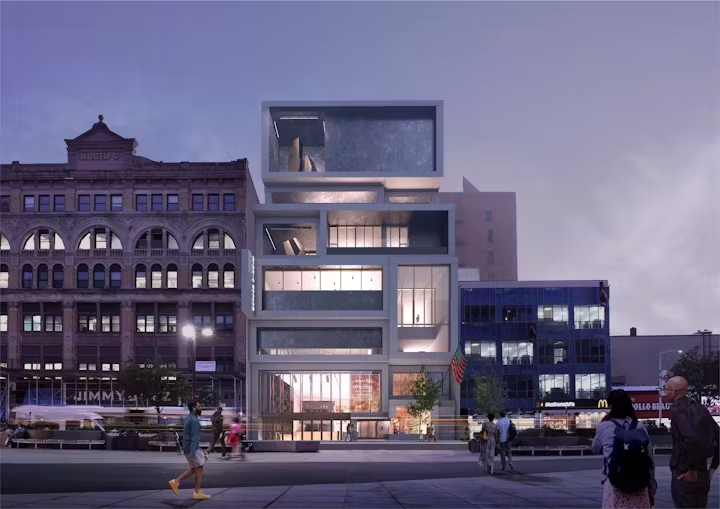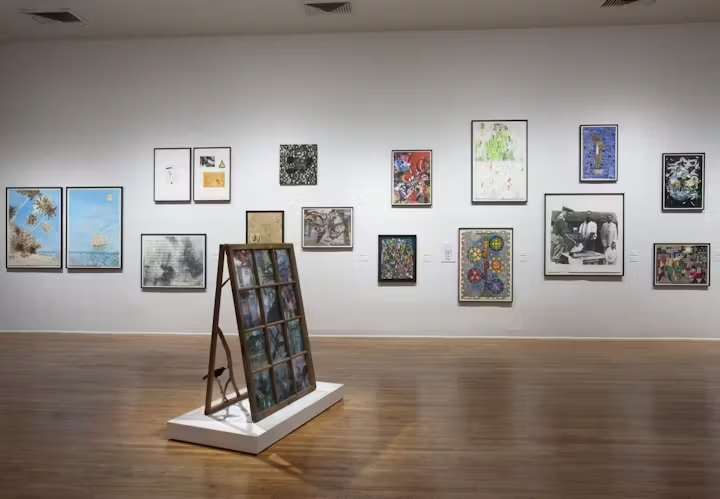Address: 144 West 125th Street New York
Phone: 212-864-4500

About
The Studio Museum in Harlem is the nexus for artists of African descent locally, nationally, and internationally and for work that has been inspired and influenced by Black culture. It is a site for the dynamic exchange of ideas about art and society.

1968
Envisioned by a diverse group of artists, activists, philanthropists and Harlem residents, The Studio Museum in Harlem opens in a 8,700-square foot loft space at 2033 Fifth Avenue, just north of 125th Street.
1968
Envisioned by a diverse group of artists, activists, philanthropists and Harlem residents, The Studio Museum in Harlem opens in a 8,700-square foot loft space at 2033 Fifth Avenue, just north of 125th Street.
1968
Electronic Refractions II is the inaugural exhibition at The Studio Museum in Harlem.
1968
(L-R) Eleanor Holmes Norton, Carter Burden, Charles E. Inniss, Campbell Wylly, Betty Blayton-Taylor, and Frank Donnelly at The Studio Museum in Harlem on opening night.
July 1969
Edward S. Spriggs is named Director.
1975
Courtney Callender is named Director.
1977
Mary Schmidt Campbell is named Director, and oversees a search for a larger museum space that would accommodate expanded exhibitions, programming and storage space.
06/15/1982
On June 15, 1982, the Studio Museum opens in its new home at 144 West 125th Street., the former New York Bank for Savings renovated by J. Max Bond, Jr.
June 1982
Ritual and Myth: A Survey of African-American Art assembles over seventy works by forty-five artists, spanning African art to contemporary installation. It is the first exhibition in the Museum’s new building.
May 1985
The Museum begins excavation of an adjacent vacant lot at 142 West 125th Street, leased from the City of New York
May 1985
Tradition and Conflict: Images of a Turbulent Decade 1963-1973 displays the work of artists who grappled with the Civil Rights Movement and its immediate aftermath.
08/07/1988
Kinshasha Holman Conwill is named Director.
May 1990
The Decade Show: Frameworks of Identity in the 1980s, a landmark collaboration with the New Museum for Contemporary Art and Museum of Contemporary Hispanic Art, displays art of the “identity politics” era.
1994
The Studio Museum in Harlem: 25 Years of African-American Art, a permanent collection exhibition, celebrates the twenty-fifth anniversary of the Museum and travels to over ten museums around the country.
January 1996
Explorations in the City of Light: African-American Artists in Paris 1945-1965 explores the relationship of African-American artists to Paris as a modernist cultural center in the mid-twentieth century.
March 1999
To Conserve a Legacy: American Art from Historically Black Colleges and Universities displays 19th and 20th century American art from HBCU collections. It is co-organized with the Addison Gallery of American Art, Andover, MA, in association with Clark Atlanta University, Fisk University, Hampton University, Howard University, North Carolina Central University, and Tuskegee University.
2000
Lowery Stokes Sims becomes Director, with Thelma Golden as Deputy Director for Exhibitions and Programs.
2000
Expanding the Walls, an annual program for local teenagers to learn the techniques and history of photography and engage the James Van Der Zee archive, begins.
April 2001
Freestyle, the first of the “F-Show” exhibitions showcasing young, emerging artists of African descent, opens, curated by Thelma Golden with Christine Y. Kim.
2001
Lobby and gift shop upgrade completed.
04/04/2002
Black Romantic: The Figurative Impulse in Contemporary African-American Art displays work focusing on the prevalence of the figure in work by African-American artists.
January 2003
Challenge of the Modern: African-American Artists 1925-1945 presents African-American artists and the legacies of Modernism.
2005
Thelma Golden is named Director and Chief Curator.
September 2005
Frequency, the second exhibition in the Museum’s series committed to young emerging artists, is mounted in the museum space.
2005
The Museum adds David Hammons’s Untitled (2004) to the outside of the museum building, where it has become a signature and recognizable part of the Museum’s identity in Harlem.
2005
Studio magazine is launched, which will go on to be recognized as a leader in museum magazine innovation.
April 2006
Energy/Experimentation: Black Artists and Abstraction 1964-1980 presents a focused group of African-American artists working in abstraction in the twentieth-century, additionally exploring the relationship between politics and abstraction.
2007
Musician and jazz impresario George Wein founds the Joyce Alexander Wein Artist Prize to honor his late wife, a long-time Trustee of the Studio Museum. The annual $50,000 award recognizes and honors the artistic achievements of an African-American artist who demonstrates great innovation, promise and creativity.
April 2008
Flow, the third exhibition in the Museum’s series committed to young emerging artists, is mounted in the museum space.
2012
Harlem Postcards commissions artists to photograph Harlem, and turns their unique depictions of the neighborhood into free, limited-edition postcards. Begun in 2002, the project was created to provide alternative, multifaceted views of Harlem, representing its complex and diverse history, and capturing the community in a critical moment of growth and change.
2012
Fore, the fourth exhibition in the Museum’s series committed to young emerging artists, is mounted in the museum space.
2015
Studio magazine wins first prize in the 2015 AAM Museum Publications Design Competition in the Magazines/Scholarly Journals category.
2015
The Museum announces plans for a new home on Manhattan’s West 125th Street, replacing its current facility with a structure designed expressly for its program by architect David Adjaye. The new building, designed by Adjaye Associates, with Cooper Robertson as executive architects and program planning consultants, will enable the Studio Museum to better serve its growing and diverse audiences.
2016
The Studio Museum in Harlem and the Frances Young Tang Teaching Museum and Art Gallery at Skidmore present an exhibition featuring works from every period in painter Alma Thomas’s career, including rarely exhibited watercolors and early abstractions, as well as her signature canvases drawn from a variety of private and public collections.
2016
The Museum begins a new set of initiatives designed to explore dynamic ways to work in the community and take the institution beyond its walls with four public art installations in Harlem’s Historic Parks. inHarlem encompasses a wide range of artistic and programmatic ventures, from site-specific artists’ projects to collaborative presentations with civic and cultural partners in the Harlem neighborhood.
2017
Fictions, the fifth exhibition in the Museum’s series committed to young emerging artists, is mounted in the museum space.
2018
The Museum closes its building to begin preparation for construction, shifting programming to partner sites throughout Harlem and beyond.
1969
Harlem Artists ’69 the culminating exhibition of the Museum’s first exhibition season.





